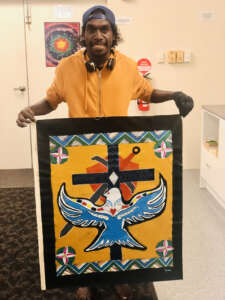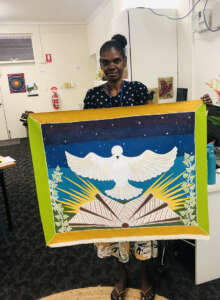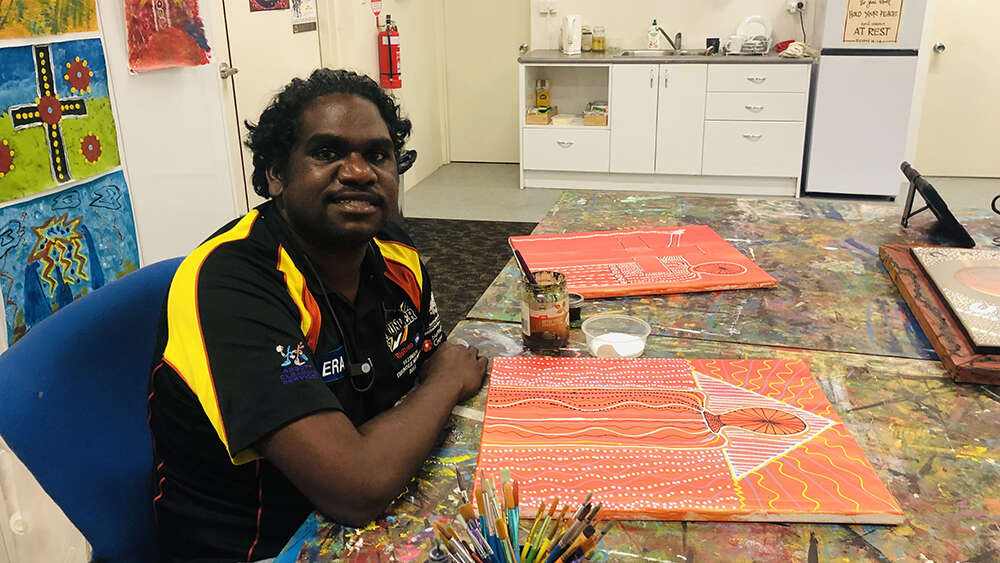For First Nations artists 'Christianity flows like water'
Aboriginal Christian painters from Top End remote communities are discovering new horizons in visual storytelling at Nungalinya College in Darwin.
In a hut on the college’s serene campus, three men and five women are intently hunched over their canvases, exploring fresh ways to express their faith in art. They are part of the first cohort of the College’s first art course since the early 2000s, which offers Certificate II in Visual Arts with an emphasis on integrating arts, culture and faith.
Some are established artists, while others are weavers or illustrators who are painting for the first time. All are exploring biblical themes in ways that connect their Aboriginal cultural traditions with their Christian faith.
There is a sense of excitement in the room as these artists diligently and expertly prepare for an exhibition at the college on August 13 and 14, where their artworks will be available for sale.
They all seem to appreciate having a spiritually safe space in which to explore deep questions around art, spirituality and faith.
“This course has given me new ideas,” says Troy Mardigan, 25, from Daly River near Katherine, as he works with dazzling speed on a painting of God the Father. It’s the final painting of three depicting Father, Son and Holy Spirit, in which he uses traditional stylistic patterns to highlight the mystery of the Trinity.
“It’s different to doing traditional painting. It’s not like with Christianity when it just flows like water. Aboriginal painting takes time and you got to go slowly to tell the story.”
Troy, whose other paintings include an image of bush tucker to illustrate the resurrection of Jesus at Easter, says he feels freer in his expression when painting a Christian subject.
“I’m full of ideas and follow up new stories that are coming in my mind. So we connect those stories and putting Christianity with them just flows smoothly for me.”
The Art and Faith course was inspired by Bible Society Australia’s book Our Mob, God’s Story, which showcased the talents of Aboriginal Christian artists from around the country, many of whom had been students at Nungalinya College.
The course was designed to assist established artists to develop their artistic skills, create and sell their own work in their local community art centres and also grow a market for Indigenous Christian art in the Top End.
Two groups of Aboriginal artists travelled to Darwin from 10 different communities to undertake four-week intensive classes in the renovated Art Training Centre, and now the first group is back for the second four-week block.
“The course balances the requirements of the formal VET sector Certificate II in Visual Arts course, but also teaching it from a Christian perspective and opening up the discussions of what people would like to express with their faith,” says the College principal Ben van Gelderen.
“Those sorts of big questions about culture, faith, ceremony-life and what things are a bit taboo, come up in other courses – how much do I leave behind? How much do I integrate? But in art, it’s really pointed, it’s right there.
“You have to make decisions. Am I going to draw with designs which come from a traditional understanding and have traditional patterns and powers along with them, or am I leaving them behind?”
The theme for the course was creation and while some artists chose to paint in a regional or clan-based tradition, others integrated distinct Christian iconography and traditions, while others experimented with something completely different.
Tyson Cooper from Minjilang in western Arnhem Land has drawn on his training as an illustrator in a powerful work titled Warrior of Christ which is inspired by Ephesians 6:11 “Put on all the armour of God so that you can defend yourself against the Devil’s tricks.”

Nungalinya artist Tyson Cooper
“This painting is about the Holy Spirit working in me helping me to grow stronger in my faith and shielding me with his powerful protection. We are all one in Christ,” he says.
Tyson says he has developed artistically through the course by being able to learn from others.
“We all help each other, we’re getting through it together he says,” before dropping to the floor to add a few dots to a painting being done by Donna Nalambana, from Warruwi in West Arnhem Land, who had never painted before undertaking this course.
Angela Malibirr from Ramingining in East Arnhem Land shows me her picture of the Bible and the Holy Spirit, which blends an image of an open Bible filled in with traditional cross-hatching underneath a Dove representing the Holy Spirit coming down from above. She quietly explains that it shows how when we spend time reading the Bible we feel something amazing, a sense of God’s presence that touches us.

Nungalinya artist Angela Malibirr
Trainer Salome Moes, who shaped the course based on her experiences of teaching art in a small remote Christian school in Gäwa on Elcho Island, is delighted with the diversity and vibrancy of paintings the students have produced. She says the artists have become like family and she hopes to continue the relationships long after the course finishes.
Ben Van Gelderen explains that the NT government is supporting the course this year under its equity pre-employment scheme which aims to support people finding new avenues for work.
“Of course, most remote communities have an art centre or are connected to another reasonably close art centre. So that’s one of the real sustainable ways to be employed.”
“So some of the units are on practical work skills like how to put on a public presentation of your art and how you prepare to work in the industry.”
The College board has committed to funding the course for at least two more years, and Ben hopes to find a way to make it a sustainable course and possibly even establish a permanent art centre on the college grounds.
Email This Story
Why not send this to a friend?


